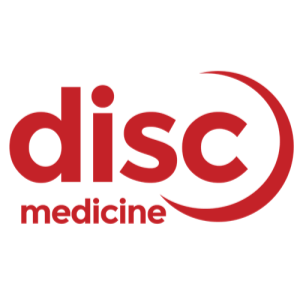Disc Medicine Presents Positive Clinical Data Updates Across Portfolio at the European Hematology Association (EHA) 2025 Annual Congress
Rhea-AI Summary
Positive
- Bitopertin showed sustained PPIX reductions and favorable long-term safety in EPP with NDA submission planned for H2 2025
- DISC-0974 achieved 50% major response rate in non-transfusion dependent MF patients with sustained hemoglobin increases
- 80% of evaluable TD Low patients achieved major response with DISC-0974, becoming transfusion independent
- DISC-3405 demonstrated proof of mechanism with 50-80% reductions in serum iron and advancement to Phase 2 trial in PV
Negative
- Only 40% of high transfusion dependent patients achieved major response with DISC-0974
Insights
Disc Medicine reports positive clinical data across all programs, strengthening development timelines with NDA planned for bitopertin in H2 2025.
Disc Medicine presented a robust collection of positive clinical data across its entire pipeline at the EHA 2025 Congress, with significant implications for the company's development trajectory. The HELIOS extension study for bitopertin in erythropoietic protoporphyria (EPP) demonstrated sustained PPIX reductions, improved quality of life, and better liver biomarkers with up to 2+ years of exposure. Most notably, the company has advanced to the registration stage with plans to submit an NDA in H2 2025, while simultaneously initiating the APOLLO confirmatory trial.
For DISC-0974 in myelofibrosis anemia, the continuation phase data showed durable responses in both non-transfusion dependent patients (50% achieving sustained hemoglobin increases ≥1.5 g/dL) and transfusion-dependent patients (80% of low-burden patients achieving transfusion independence). The exploratory cohort of the Phase 2 RALLY-MF trial for patients on momelotinib or pacritinib is fully enrolled, with initial data expected in H2 2025. Preclinical combination studies suggest synergistic potential with other anemia treatments.
The DISC-3405 program showed promising Phase 1 results with dose-related increases in hepcidin and corresponding reductions in serum iron (50-80% from baseline), supporting monthly subcutaneous dosing. The iron pulse study demonstrated 94% reduction in iron absorption at Day 2 and 68% at Day 15, validating its mechanism of action. Based on these results, Disc has initiated a Phase 2 trial in polycythemia vera with results expected in 2026.
Collectively, these updates establish clinical proof-of-concept across multiple programs and provide clear development pathways, with bitopertin advancing toward potential commercialization, DISC-0974 showing promising efficacy in a difficult-to-treat condition, and DISC-3405 demonstrating mechanism validation supporting expansion into new indications.
- Positive updates across all programs, including longer term efficacy and safety data from the HELIOS open-label extension trial of bitopertin in erythropoietic protoporphyria (EPP), additional durability data from Phase 1b study of DISC-0974 in anemia of myelofibrosis (MF), and additional data from DISC-3405 studies in healthy volunteers
- Management to host a corporate update conference call on Monday, June 16 at 8:00 am ET / 2:00 pm CEST
WATERTOWN, Mass., June 12, 2025 (GLOBE NEWSWIRE) -- Disc Medicine, Inc. (NASDAQ:IRON), a clinical-stage biopharmaceutical company focused on the discovery, development, and commercialization of novel treatments for patients suffering from serious hematologic diseases, today spotlights 5 posters presented at the EHA 2025 annual meeting in Milan, Italy. This year’s presentations included data from HELIOS, an ongoing open-label extension study of bitopertin in EPP, which showed favorable long-term efficacy and safety with sustained protoporphyrin IX (PPIX) reductions, improvement in quality of life, and improved liver biomarkers. Disc is advancing development and registrational activities for bitopertin in EPP, with plans to submit an NDA in H2 2025. The company has initiated APOLLO, a confirmatory clinical trial of bitopertin in adults and adolescents with EPP. Disc recently launched a campaign to raise awareness of EPP among physicians, patients, and caregivers with emphasis on the causative role of PPIX accumulation in the disease. Learn more at PPIXisWhy.com.
Disc also presented longer term data from the continuation phase of its Phase 1b trial in MF anemia, showing sustained activity on key biomarkers and durable anemia response among major responders. Enrollment for the Phase 2 RALLY-MF trial of DISC-0974 is ongoing with the exploratory cohort for patients on concomitant momelotinib or pacritinib fully enrolled. The company expects to present initial RALLY-MF data in H2 2025. Additionally, Disc shared an update of the Phase 1 healthy volunteer trial of DISC-3405, initially presented at ASH 2024, which demonstrated deep, sustained reductions in serum iron and meaningful changes in hematologic parameters, establishing proof of mechanism. Based on these data, the company has initiated a Phase 2 trial of DISC-3405 in polycythemia vera (PV). Disc also presented an iron pulse study of DISC-3405 in healthy volunteers which showed inhibition of dietary iron uptake, further confirming the mechanism of action and supporting DISC-3405’s potential in diseases of iron overload.
The collection of data presented at EHA adds to the evidence base supporting Disc’s continued advancement of all three clinical candidates and provides support for expansion opportunities in new indications. Management will host a call to review these updates on June 16 at 8:00 am ET. Please register for the event on the Events and Presentations page of Disc’s website (https://ir.discmedicine.com/)
Bitopertin, DISC-0974, and DISC-3405 are investigational agents and are not approved for use as therapies in any jurisdiction worldwide.
Summary of Poster Presentations
Bitopertin:
HELIOS:
HELIOS is an ongoing Phase 2, open-label, long-term extension trial that enrolled 86 adult and adolescent patients with EPP from the BEACON and AURORA trials. Patients were randomized to receive 20 mg or 60 mg bitopertin in BEACON and 20 mg or 60 mg bitopertin or placebo in AURORA, with all patients transitioning to a 60 mg daily dose of bitopertin in HELIOS.
- Longer term treatment with bitopertin was associated with sustained reductions in the disease-causing toxin PPIX, with additional benefit for patients receiving the 60 mg dose continuously
- Continuous treatment with 60 mg of bitopertin reduced ALT and other exploratory hepatobiliary biomarkers
- Nearly all participants reported substantial improvements in quality of life measures
- Bitopertin exhibited a favorable longer-term safety profile with up to 2+ years of exposure and similar safety across adults and adolescents with EPP and XLP
DISC-0974:
DISC-0974 Phase 1b in MF anemia:
Data from the continuation phase of the Phase 1b trial of DISC-0974 in MF anemia as of October 2024 were presented. This multi-center, open-label trial included patients who were: non-transfusion dependent receiving no transfusions (nTD, n=23), transfusion dependent with low transfusion burden (TD Low, n=5) and transfusion dependent with high transfusion burden (TD High, n=7). The trial was comprised of both patients receiving concomitant JAK inhibitor therapy (n=13) and not receiving JAK inhibitor therapy (n=22). DISC-0974 was administered subcutaneously at 14 mg (n=1), 28 mg (n=7), 50 mg (n=12), 75 mg (n=9), or 100 mg (n=6) every 4 weeks for up to 6 treatments. Long-term results demonstrated:
- Sustained hepcidin suppression, iron mobilization, and reduction in Zinc PPIX, a measure of iron restricted hemoglobin production
- nTD patients:
50% of evaluable patients achieved major response of sustained mean hemoglobin increase of ≥1.5 g/dL- Hematologic improvement was durable through the continuation phase
- TD Low patients:
80% of evaluable patients achieved major response of transfusion independence over 16 weeks- Hematologic improvement was durable, and all major responders remained transfusion independent during the continuation phase
- TD High patients:
40% of evaluable patients achieved major response of transfusion independence over 12 weeks- 1 of 2 patients with a major response entered the continuation phase and remained transfusion independent at Day 225, with follow-up ongoing
- DISC-0974 was safe and well-tolerated at all evaluated dose levels
DISC-0974 in combination with luspatercept and ESA (mouse model):
The effect of DISC-0974, luspatercept, and ESA as single agents and DISC-0974 combined with luspatercept or ESA on hematological parameters in wild type mice was evaluated. Results showed:
- Treatment with DBIO-100 (a mouse analog of DISC-0974) suppressed hepcidin, enhanced iron availability, and boosted erythropoiesis in wild-type mice
- Combining with DPO (ESA) or RAP-536 (mouse analog of luspatercept) led to additional hematological benefits beyond those agents alone
These results demonstrate that DISC-0974 has a distinct mechanism of action among anemia-targeted agents and highlight the potential for synergistic anemia benefits when combining DISC-0974 with other anemia-targeted agents.
DISC-3405:
Phase 1 Healthy Volunteer Study:
Updated SAD/MAD data from the Phase 1 trial of DISC-3405 in healthy volunteers were presented. In the SAD portion of this trial, healthy males and females ages 18 to 65 were given a single dose of placebo (n=10) or DISC-3405 at 75 mg intravenously (IV) (n=6), 37.5 mg subcutaneously (SC) (n=6), 75 mg SC (n=6), 150 mg SC (n=6), or 300 mg SC (n=6). The MAD portion included placebo (n=4), 75 mg SC (n=6), and 150 mg SC (n=6) cohorts dosed every 4 weeks for a total of 2 doses. Consistent with data presented at ASH 2024, results showed:
- DISC-3405 produced dose-related increases in serum hepcidin with corresponding reductions in serum iron across all dose levels
- DISC-3405 resulted in deep reductions in serum iron (ranging from 50
-80% from baseline) that were sustained and support a once-monthly SC dosing regimen - Single and repeat dosing of DISC-3405 demonstrated meaningful reductions in hematologic parameters, including reticulocyte hemoglobin, hemoglobin, and hematocrit
- DISC-3405 was generally well-tolerated at all evaluated dose levels, with no serious adverse events (AEs), greater than Grade 2 AEs, or AEs leading to study withdrawal
These results provide proof of mechanism and support the advancement DISC-3405 into proof of concept studies. Disc has now initiated a Phase 2 trial of DISC-3405 in PV with initial results expected in 2026.
Iron Pulse Study:
Disc conducted an iron pulse study in healthy volunteers to evaluate the effectiveness of DISC-3405 in inhibiting dietary iron uptake. N=8 healthy volunteers received placebo treatment followed by oral ferrous sulfate tablets on two sequential occasions to establish baseline iron absorption profiles. Participants were then given a single 150mg IV dose of DISC-3405, followed by oral ferrous sulfate “iron pulses” on the 2nd and 15th days following treatment. DISC-3405 resulted in an average
These results confirm the mechanism of DISC-3405 and demonstrate its ability to block dietary iron absorption, supporting the potential for treating diseases associated with iron overload.
About Disc Medicine
Disc Medicine is a clinical-stage biopharmaceutical company committed to discovering, developing, and commercializing novel treatments for patients who suffer from serious hematologic diseases. We are building a portfolio of innovative, potentially first-in-class therapeutic candidates that aim to address a wide spectrum of hematologic diseases by targeting fundamental biological pathways of red blood cell biology, specifically heme biosynthesis and iron homeostasis. For more information, please visit www.discmedicine.com.
Disc Cautionary Statement Regarding Forward-Looking Statements
This press release contains “forward-looking statements” within the meaning of the Private Securities Litigation Reform Act of 1995, including, but not limited to, express or implied statements regarding Disc’s expectations with respect to the next stages of its development programs for bitopertin, DISC-0974 and DISC-3405, including projected timelines for the initiation and completion of its clinical trials, anticipated timing of release of data, and other clinical activities; the registrational pathway for bitopertin, including the timing of a potential NDA submission; and the potential of its development programs in new indications. The use of words such as, but not limited to, “believe,” “expect,” “estimate,” “project,” “intend,” “future,” “potential,” “continue,” “may,” “might,” “plan,” “will,” “should,” “seek,” “anticipate,” or “could” or the negative of these terms and other similar words or expressions that are intended to identify forward-looking statements. Forward-looking statements are neither historical facts nor assurances of future performance. Instead, they are based on Disc’s current beliefs, expectations and assumptions regarding the future of Disc’s business, future plans and strategies, clinical results and other future conditions. New risks and uncertainties may emerge from time to time, and it is not possible to predict all risks and uncertainties. No representations or warranties (expressed or implied) are made about the accuracy of any such forward-looking statements.
Disc may not actually achieve the plans, intentions or expectations disclosed in these forward-looking statements, and investors should not place undue reliance on these forward-looking statements. Actual results or events could differ materially from the plans, intentions and expectations disclosed in the forward-looking statements as a result of a number of material risks and uncertainties including but not limited to: the adequacy of Disc’s capital to support its future operations and its ability to successfully initiate and complete clinical trials; the nature, strategy and focus of Disc; the difficulty in predicting the time and cost of development of Disc’s product candidates; Disc’s plans to research, develop and commercialize its current and future product candidates; the timing of initiation of Disc’s planned preclinical studies and clinical trials; the timing of the availability of data from Disc’s clinical trials; Disc’s ability to identify additional product candidates with significant commercial potential and to expand its pipeline in hematological diseases; the timing and anticipated results of Disc’s preclinical studies and clinical trials and the risk that the results of Disc’s preclinical studies and clinical trials may not be predictive of future results in connection with future studies or clinical trials and may not support further development and marketing approval; and the other risks and uncertainties described in Disc’s filings with the Securities and Exchange Commission, including in the “Risk Factors” section of our Annual Report on Form 10-K for the year ended December 31, 2024, and in subsequent Quarterly Reports on Form 10-Q. Any forward-looking statement speaks only as of the date on which it was made. None of Disc, nor its affiliates, advisors or representatives, undertake any obligation to publicly update or revise any forward-looking statement, whether as result of new information, future events or otherwise, except as required by law.
Media Contact
Peg Rusconi
Deerfield Group
peg.rusconi@deerfieldgroup.com
Investor Relations Contact
Christina Tartaglia
Precision AQ
christina.tartaglia@precisionaq.com







